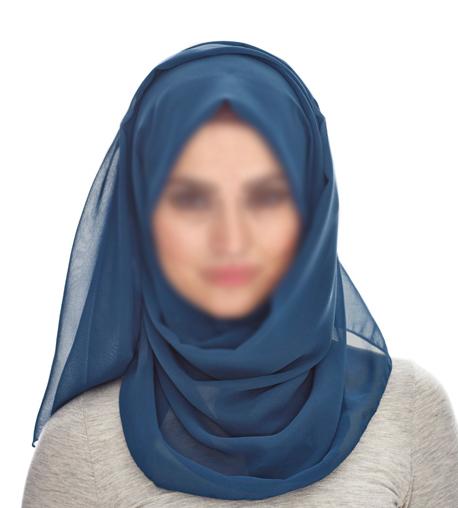Not All Head Coverings Are Created Equal

March 22, 2016
Cultural differences are receiving more negative connotation in America today. Almost every religion has some form of traditional head covering, so it’s ridiculous to pin a negative connotation to something that your religion most likely has too. Of course, there is no way to stop these unfair words from leaving people’s mouths. America has this wonderful feature that allows everyone to have freedom of speech which provides us with the right to say whatever or to promote whatever cause, religion or event without repercussions.
This ideal “lack of repercussions” doesn’t apply to people we don’t like though. If we dislike someone, or the ideals they support, we might be inclined to throw insignificant insults in their direction.
“I have the right to freedom of speech,” a man in traditional Muslim head wrapping (called a Taqiyah), but as soon as some people hear “headscarf,” some might assume the person has a certain look and have a specific demeanor about them. Then when we hear “veil” or “yamaka” the symbolism changes completely, more to thoughts of Catholicism and Judaism.
Since most religions grew off of one another, there is no reason one religion, like Islam, should be pointed out for having crazy traditions that make women wear designated articles of clothing.
That should not be the case. We should be able to put any prejudice aside for the sake of respecting the person we are associating with.
Like I said, most religions grew from one another and reformed and then people converted to different paths of faith. The first five religions to be documented where Judaism, Islam, Hinduism, Christianity and Buddhism. All of which, share similar ideals of love, peace and morality. Thus having religious head coverings, of any kind, should not be seen as oppressive on men or women.
As a symbol of modesty and respect, Islamic men and women should not be singled out for their choice of religious dress. People making assumptions and accusations against those who choose to dress this way, might directly correlate all Islamic people to terrorist attacks.
After 9/11, there was a spike in “random” security searches at airports. These “random” searches often singled out men and women wearing such religious attire; other times, middle- eastern families and individuals were stopped. Out of these searches, only a minuscule fraction of these travelers were dangerous. More security checks, and security enhancements at airports didn’t provide as much reassurance as authority powers thought. A high portion of the population began to stereotype another race, religion and society of people, when in reality, there are only a few bad apples.
The analogy of society to a tree can explain this situation very well. There are ripe and crisp apples that get plenty of sunlight and other privileges that apples might get, and then there are apples who grew quickly and healthily, but don’t appreciate the work that some other apples might have to experience. They might start to rot as they judge more and more, even the other apples who might not have grown the same way, are still grown and healthy apples.
Blaming a whole race and religious following is taking a serious issue into uncharted territory. There should be no reason for middle-eastern families to be stopped at airports more than anyone else. This assumption that “all terrorists are Muslims, so we need to send them all back to where they came from,” is an aggressive take on a situation that shouldn’t actually play out. It’s like if a couple sat at the dinner table saying, “Honey, I want meatloaf,” even though a plate of tacos was sitting in front of them. The significant other shakes their head, gesturing to the plate of tacos. “Well, it’s meatloaf or divorce!” she exclaims.
Does that make sense? Not really…
The general population stereotypes, which doesn’t benefit any one the people being stereotyped. Whether they’re being discriminated and stereotyped for their race and ethnicity or their religious affiliation.
Apparently in America, religious head coverings are only stereotyped in Islamic and Muslim cultures, and not in Christianity, Judaism or in Amish practice. Those head coverings are just, head coverings, but Muslim women and men wearing head coverings are considered suggestive to violent behaviors (going against the basic standards and scriptures in the Muslim and Islamic faith).
Head coverings, of any style, can be found through every documented religion for one reason or another. For example, followers of Christianity can wear veils, of specified lengths during seasons of Lent, Advent, Easter and at weddings (whether or not they are the person being wed or not). So, I guess it’s OK for Muslim or Islam men and women to be criticized for choosing to dress a certain way, but no one would question a Catholic brother or sister (nun or monk) for wearing their religious veils or caps…
Most head coverings have biblical references within the religion’s scripture. They are symbols of modesty, not oppression; they are symbols of privacy and respect, not oppression; they are symbols of devotion, not oppression.
They are not meant to oppress people. Take the Jewish head coverings: the shpitzel, a wig or half wig worn traditionally by Orthodox women, and the yamaka, a Kippot worn by (traditionally) Orthodox men. Not of these head dresses are considered oppressive or symbols of aggression. They represent the religion, nothing else.
Even Amish and Quaker followers wear head scarves, hats or caps. They are meant to take the focus off of a person’s external appearance (modesty), so the person such an individual is interaction with might actually be able to focus on the physical interaction they are having (respect).
Highlighting the use of head coverings in other religions is important because we cannot stereotype a group of people based on religion. It is in our Constitution, not to make this about politics, but we should not deprive a religious following of their basic rights as American citizens.
The dangerous stigma behind the hijab, dupatta and turban is the main point of focus for many people, and it shouldn’t be by any means.
Here is a very real example: let’s say you are talking to another person (disregard gender, race, and religion). You start a conversation with the person, but then they notice what shirt you’re wearing. It says nothing. It’s just one, solid color. Let’s say it’s that person’s least favorite color. They can’t focus on the conversation anymore, and you find them continuously staring at your shirt. Even if you try to re engage them, they continue to stare at your shirt. Later you hear from a friend that this person you talked with said, “All people who wear plain colored shirts are violent, aggressive and rude.”
Again this example doesn’t make sense…
There are people who discriminate against others based solely on aesthetic and it is a simple prejudice that can be eliminated with proper education and positive connotations to associate with specific aesthetics.
I see, and understand, some reasoning behind fearing those who wear religious headwear and abuse the peaceful name of their religion. I do not, however, understand the mental segregation people apply to a whole congregation of people. There are those who follow and respect rules and guidelines of their religion, but they are being punished by people who don’t even practice their religion.
Unfortunately, the thousands of people who respect themselves, and desire respect of those around them through wearing culturally significant dress are disrespected casually in our daily lives. We should not enable people to be so disrespectful to anyone, regardless of their personal choices.


LaEl Pierce • Apr 17, 2024 at 10:44 pm
The early Christian church used hijab style head coverings before mohammed was even born.